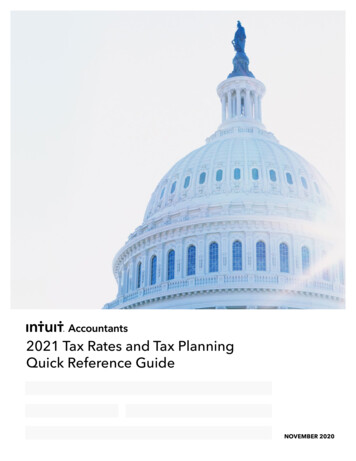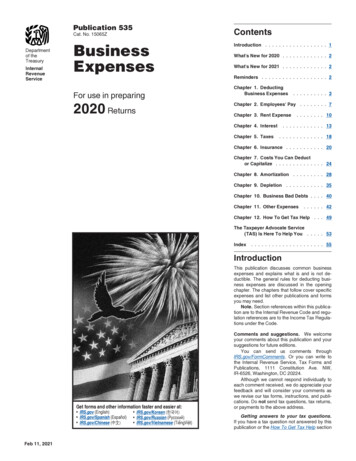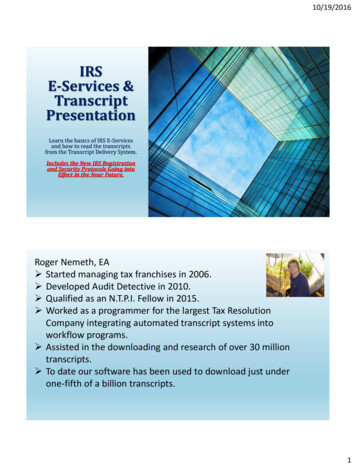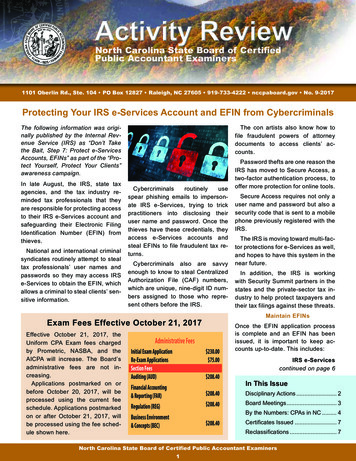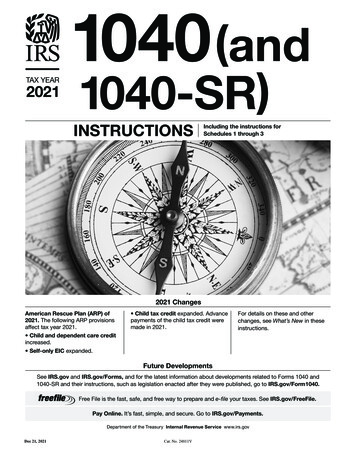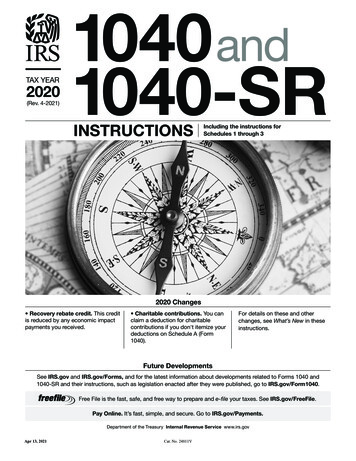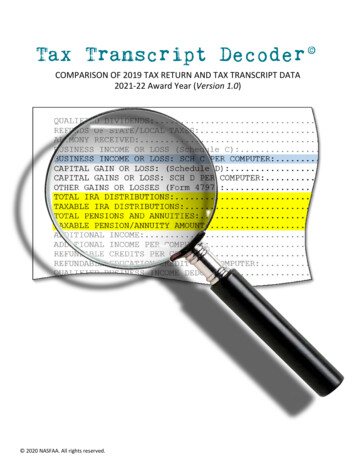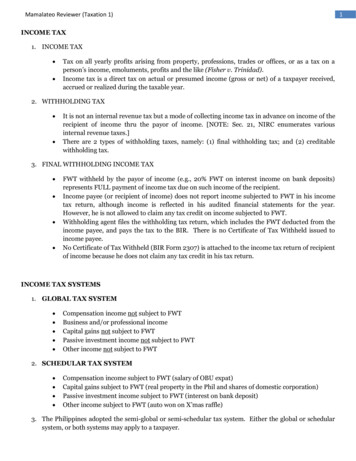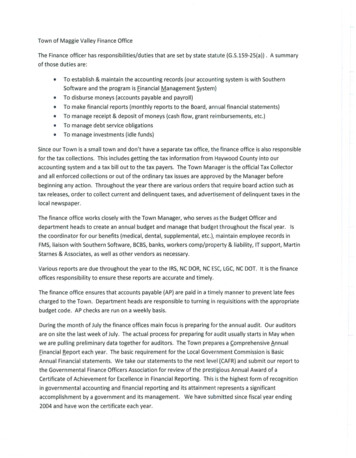
Transcription
Departmentof theTreasuryYour FederalIncome TaxFor IndividualsPublication 17Catalog Number 10311GFor use in preparing2021 ReturnsInternalRevenueServiceTAX GUIDE2021Get forms and other information faster and easier at: IRS.gov (English) IRS.gov/Spanish (Español)Dec 16, 2021 IRS.gov/Chinese (中文) IRS.gov/Korean (한국어) IRS.gov/Russian (Pусский) IRS.gov/Vietnamese (Tiếng Việt)
Your FederalIncome TaxDepartmentof theTreasuryFor IndividualsInternalRevenueServiceContentsWhat's New. 1Reminders . . . . . . . . . . . . . . . . . . . . . . . .3Introduction . . . . . . . . . . . . . . . . . . . . . . .4Part One. The Income Tax Return . . . .1 Filing Information . . . . . . . . . . .2 Filing Status . . . . . . . . . . . . . .3 Dependents . . . . . . . . . . . . . .4 Tax Withholding and Estimated Tax.Part Two. Income and Adjustmentsto Income . . . . . . . . . . . . . . . . . .5 Wages, Salaries, and Other Earnings .6 Interest Income . . . . . . . . . . . . . .7 Social Security and Equivalent RailroadRetirement Benefits . . . . . . . . . . .8 Other Income . . . . . . . . . . . . . . .9 Individual Retirement Arrangements(IRAs) . . . . . . . . . . . . . . . . . .66222637. . . 46. . . 47. . . 5411 Taxes . . . . . . . . . . . . . . . . . . . . . . 9512 Other Itemized Deductions . . . . . . . . . . 99Part Four. Figuring Your Taxes, andRefundable and Nonrefundable Credits . . 10513 How To Figure Your Tax . . . . . . . . . . . 10514 Child Tax Credit and Credit for OtherDependents . . . . . . . . . . . . . . . . . 1072021 Tax Table. . . . . . . . . . . . . . . . . . . . 1112021 Tax Computation Worksheet. . . . . . . . 1232021 Tax Rate Schedules . . . . . . . . . . . . . . 123Your Rights as a Taxpayer . . . . . . . . . . . . . 125How To Get Tax Help. . . . . . . . . . . . . . . . 126. . . 62. . . 67Index. . . 76Where To File . . . . . . . . . . . . . . . . . . . . . 138. . . . . . . . . . . . . . . . . . . . . . . . . . 128Part Three. Standard Deduction, ItemizedDeductions, and Other Deductions . . . . . . 9110 Standard Deduction . . . . . . . . . . . . . . 91All material in thispublication may bereprinted freely. Acitation to Your FederalIncome Tax (2021)would be appropriate.The explanations and examples in this publicationreflect the interpretation by the Internal Revenue Service(IRS) of: Tax laws enacted by Congress, Treasury regulations, and Court decisions.However, the information given does not cover everysituation and is not intended to replace the law or changeits meaning.This publication covers some subjects on which acourt may have made a decision more favorable totaxpayers than the interpretation by the IRS. Until thesediffering interpretations are resolved by higher courtdecisions or in some other way, this publication willcontinue to present the interpretations by the IRS.All taxpayers have important rights when working withthe IRS. These rights are described in Your Rights as aTaxpayer in the back of this publication.
What's NewThis section summarizes importanttax changes that took effect in2021. Most of these changes arediscussedinmoredetailthroughout this publication.Future developments. For thelatest information about the tax lawtopics covered in this publication,such as legislation enacted after itwas published, go to IRS.gov/Pub17.Due date of return. File Form1040 or 1040-SR by April 18, 2022.The due date is April 18, instead ofApril 15, because of the Emancipation Day holiday in the District ofColumbia—even if you don’t live inthe District of Columbia. If you livein Maine or Massachusetts, youhave until April 19, 2022. That isbecause of the Patriots' Day holiday in those states. See chapter 1,later.Who must file. Generally, theamount of income you can receivebefore you must file a return hasbeen increased. For more information, see chapter 1, later.Tuition and fees deduction notavailable. The tuition and fees deduction is not available after 2020.Instead, the income limitations forthe lifetime learning credit havebeen increased. See Form 8863and its instructions.Economic impact payment—EIP3. Any economic impact paymentyou received is not taxable for federal income tax purposes, but willreduce your recovery rebate credit.2021 Recovery Rebate Credit.This credit is figured like last year'seconomic impact payment, EIP 3,except eligibility and the amount ofthe credit are based on your taxyear 2021 information. See the instructions for Form 1040, line 30,and the Recovery Rebate CreditWorksheet to figure your creditamount.Who must file. Generally, theamount of income you can receivebefore you must file a return hasbeen increased. For more information, see the Instructions for Form1040.Standard deduction amount increased. For 2021, the standarddeduction amount has been increased for all filers. The amountsare: Single or Married filing separately— 12,550; Married filing jointly or Qualifying widow(er)— 25,100; and Head of household— 18,800.Publication 17 (2021)See chapter 10, later.If you elect to not itemizeTIP your deductions in 2021,you may qualify to take adeduction for charitable contributions of up to 300 ( 600 in thecase of a joint return). For more information, see Pub. 526, Charitable Contributions.Virtual currency. If, in 2021, youengaged in a transaction involvingvirtual currency, you will need toanswer “Yes” to the question onpage 1 of Form 1040 or 1040-SR.See Virtual Currency in the Instructions for Form 1040 for informationon transactions involving virtualcurrency. Do not leave this fieldblank. The question must be answered by all taxpayers, not justtaxpayers who engaged in a transaction involving virtual currency.Credits for sick and family leavefor certain self-employed individuals. The Families First Coronavirus Response Act (FFCRA)helped self-employed individualsaffected by coronavirus by providing paid sick leave and paid familyleave credits equivalent to thosethat employers are required to provide their employees for qualifiedsick leave wages and qualifiedfamilyleavewages.TheCOVID-related Tax Relief Act of2020 extended the period duringwhich individuals can claim thesecredits. For more information, seethe Instructions for Form 7202 andSchedule 3 (Form 1040), line 13b.Extension and expansion ofcredit for qualified sick andfamily leave wages. The American Rescue Plan Act of 2021 (theARP), enacted on March 11, 2021,provides that certain self-employedindividuals can claim credits for upto 10 days of “paid sick leave,” andup to 60 days of “paid familyleave,” if they are unable to work ortelework due to circumstances related to coronavirus. Self-employed individuals may claim thesecredits for the period beginning onApril 1, 2021, and ending September 30, 2021. For more information, see the Instructions for Form7202 and Schedule 3 (Form 1040),line 13h.Form 9000, Alternative MediaPreference. Beginning in 2021,taxpayers with print disabilities canuse Form 9000 to elect to receivenotices from the IRS in an alternative format including braille, largeprint, audio, and electronic. Youcan attach Form 9000 to your Form1040 or 1040-SR or you can mail itseparately. For more information,see Form 9000.All taxpayers now eligible forIdentity Protection PIN. Beginning in 2021, the IRS Identity Protection PIN (IP PIN) Opt-In Program has been expanded to alltaxpayers who can properly verifytheir identity. An IP PIN helps prevent your social security numberfrom being used to file a fraudulentfederal income tax return. You canuse the Get An IP PIN tool onIRS.gov to request an IP PIN, fileForm 15227 if your income is 72,000 or less, or make an appointment to visit a Taxpayer Assistance Center.Direct deposit now available forreturns filed late. You can nowreceive a direct deposit of your refund even if you file your 2021 return after November 30, 2022.Expanded dependent care assistance. The ARP expanded thechild and dependent care tax creditfor 2021 by making it refundablefor certain taxpayers and making itlarger. For 2021, the dollar limit onqualifying expenses increases to 8,000 for one qualifying personand 16,000 for two or more qualifying persons. The rules for calculating the credit have alsochanged; the percentage of qualifying expenses eligible for thecredit has increased, along withthe income limit at which the creditbegins phasing out. Additionally,for taxpayers who receive dependent care benefits from their employer, the dollar limit of the exclusion amount increases for 2021.For more information, see the Instructions for Form 2441 and Pub.503.Child tax credit. Under the ARP,the child tax credit has been enhanced for 2021. The child taxcredit has been extended to qualifying children under age 18. Depending on modified adjustedgross income, you may receive anenhanced credit amount of up to 3,600 for a qualifying child underage 6 and up to 3,000 for a qualifying child over age 5 and underage 18. The enhanced creditamount begins to phase out wheremodified adjusted gross incomeexceeds 150,000 in the case of ajoint return or surviving spouse, 112,500 in the case of a head ofhousehold, and 75,000 in all othercases.If you (or your spouse if filingjointly) lived in the United States formore than half the year, the childtax credit will be fully refundableeven if you don't have earned income. If you don't meet thisresidency requirement, your childtax credit will be a combination of anonrefundable child tax credit anda refundable additional child taxcredit, as was the case in 2020.The credit for other dependentshas not been enhanced and is figured as it was in 2020.Because of the changesmade by the ARP, deCAUTION tailed discussion of thechild tax credit and the Child TaxCredit Worksheet, which were previously part of the Instructions forForm 1040, have been moved tothe Instructions for Schedule 8812(Form 1040), Credit for QualifyingChildren and Other Dependents.!Schedule 8812 (Form 1040).The Schedule 8812 (Form 1040)and its instructions have been revised to be the single source forfiguring and reporting the child taxcredits and credit for other dependents. The instructions now includeall applicable worksheets for figuring these credits. As a result, Pub.972, Child Tax Credit, won’t be revised. For prior-year versions ofPub. 972, go to IRS.gov/Pub972.Letter 6419. If you received advance child tax credit paymentsduring 2021, you will receive Letter6419. Keep this notice for your records. You will use the informationfrom this notice to figure theamount of child tax credit to claimon your 2021 tax return or theamount of additional tax you mustreport on Schedule 2 (Form 1040).Additional tax on excess advance child tax credit payments. If you received advancechild tax credit payments during2021 and the credits you figure using Schedule 8812 (Form 1040)are less than what you received,you may owe an additional tax.Complete Schedule 8812 (Form1040) to determine if you must report an additional tax on Schedule2 (Form 1040).Premium tax credit (PTC). TheARP expanded the PTC by eliminating the limitation that a taxpayer's household income may not exceed 400% of the federal povertyline and generally increases thecredit amounts. In addition, in2021, if you receive unemploymentcompensation, you are generallyeligible to claim the PTC if youmeet the other requirements. Formore information, see Pub. 974and Form 8962 and its instructions.Page 1
Changes to the earned incomecredit (EIC). For 2021, the following changes have been made tothe EIC. EIC rules for taxpayerswithout a qualifying child.Special rules apply if you areclaiming the EIC without aqualifying child. In these cases, the minimum age hasbeen lowered to age 19 except for specified studentswho must be at least age 24at the end of the year. However, the applicable minimumage is lowered further for former foster youth and qualifiedhomeless youth to age 18.Additionally, you no longerneed to be under age 65 toclaim the EIC without a qualifying child. EIC rules for taxpayers witha qualifying child. If you areclaiming the EIC with a qualifying child, you should followthe rules that apply to filerswith a qualifying child or children when determiningwhether you are eligible toclaim the EIC even if yourqualifying child hasn't been issued a valid SSN on or beforethe due date of your return (including extensions). However,when determining the amountof EIC that you are eligible toclaim on your return, youshould follow the rules thatapply to taxpayers who do nothave a qualifying child. Phaseout amounts in-creased. The amount of thecredit has been increased andthe phaseout income limits atwhich you can claim the credithave been expanded. Rules for separated spou-ses. If you are married butdon't file a joint return, youmay qualify to claim the EIC ifyou live with a qualifying childfor more than half the yearand either live apart from yourspouse for the last 6 monthsof 2021 or are legally separated according to your statelaw under a written separationagreement or a decree of separate maintenance and do notlive in the same household asyour spouse at the end 2021. Investment income limit in-creased. The amount of investment income you can receive and still be eligible toclaim the EIC has increased to 10,000. Prior year (2019) earned income. You can elect to useyour 2019 earned income toPage 2figure your 2021 earned income credit if your 2019earned income is more thanyour 2021 earned income.See the instructions for Form1040, line 27a.File Schedule EIC (Form 1040) ifyou have a qualifying child. Ifyou have at least one child whomeets the conditions to be yourqualifying child for purposes ofclaiming the EIC, complete and attach Schedule EIC to your Form1040 or 1040-SR even if that childdoesn't have a valid SSN. Formore information, including how tocomplete Schedule EIC if yourqualifying child doesn't have a validSSN, see the instructions for Form1040, line 27a, and Schedule EIC.Forgiveness of Paycheck Protection Program (PPP) loans.The forgiveness of a PPP loan creates tax-exempt income, so youdon't need to report the income onForm 1040 or 1040-SR, but you doneed to report certain informationrelated to your PPP loan. To findout how to report information related to your PPP loan, see Forgiveness of Paycheck Protection Program (PPP) Loans under Income inthe Instructions for Form 1040.Identity verification. The IRSlaunched an improved identity verification and sign-in process thatenables more people to securelyaccess and use IRS online toolsand applications. To provide verification services, the IRS is usingID.me, a trusted technology provider. The new process is onemore step the IRS is taking to ensure that taxpayer information isprovided only to the person who legally has a right to the data. Taxpayers using the new mobile-friendly verification procedurecan gain entry to existing IRS online services such as the Child TaxCredit Update Portal, On-line Account, Get Transcript Online, Getan Identity Protection PIN (IP PIN),and Online Payment Agreement.Additional IRS applications willtransition to the new method overthe next year. Each online servicewill also provide information thatwill instruct taxpayers on the stepsthey need to follow for access tothe service. You can also seeIR-2021-228 for more information.Personal protective equipment(PPE). Amounts paid for PPE,such as masks, hand sanitizer, andsanitizing wipes, for the primarypurpose of preventing the spreadof coronavirus, are qualified medical expenses. If the amounts werepaid or reimbursed under a healthflexible spending account, Archermedical savings account, healthreimbursement arrangement, orany other health plan, the amountsare not deductible on Schedule A(Form 1040).Standard mileage rates. Thestandard mileage rate allowed foroperating expenses for a car whenyou use it for medical reasons decreased to 16 cents a mile. The2021 rate for use of your vehicle todo volunteer work for certain charitable organizations remains at 14cents a mile and the rate for business use of a vehicle is 56 cents amile.Modified AGI limit for traditionalIRA contributions. For 2021, ifyou are covered by a retirementplan at work, your deduction forcontributions to a traditional IRA isreduced (phased out) if your modified AGI is: More than 105,000 but lessthan 125,000 for a marriedcouple filing a joint return or aqualifying widow(er), More than 66,000 but lessthan 76,000 for a single individual or head of household,or Less than 10,000 for a mar-ried individual filing a separatereturn.If you either live with your spouseor file a joint return, and yourspouse is covered by a retirementplan at work but you aren’t, yourdeduction is phased out if yourmodified AGI is more than 198,000 but less than 208,000. Ifyour modified AGI is 206,000 ormore, you can’t take a deductionfor contributions to a traditionalIRA. See How Much Can You Deduct in chapter 9, later.Modified AGI limit for Roth IRAcontributions. For 2021, yourRoth IRA contribution limit is reduced (phased out) in the followingsituations. Your filing status is married filing jointly or qualifyingwidow(er) and your modifiedAGI is at least 198,000. Youcan’t make a Roth IRA contribution if your modified AGI is 208,000 or more. Your filing status is single,head of household, or marriedfiling separately and you didn’tlive with your spouse at anytime in 2021 and your modified AGI is at least 125,000.You can’t make a Roth IRAcontribution if your modifiedAGI is 140,000 or more. Your filing status is married filing separately, you lived withyour spouse at any time during the year, and your modified AGI is more than zero.You can’t make a Roth IRAcontribution if your modifiedAGI is 10,000 or more. SeeCan You Contribute to a RothIRA in chapter 9, later.2022 modified AGI limits. Youcan find information about the2022 contribution and AGI limits inPub. 590-A.Form 1040-X continuous-useform and instructions. Form1040-X, Amended U.S. IndividualIncome Tax Return, and its instructions have been converted from anannual revision to continuous usebeginning in tax year 2021. Boththe form and instructions will beupdated as required. For the mostrecent version, go to IRS.gov/Form1040X. Section discussionsand charts that were updated annually have been removed, or replaced with references to relevantforms, schedules, instructions, andpublications. See the forms,schedules, instructions, and publications for the year of the tax return you are amending for guidance on specific topics.Business meals. Section 210 ofthe Taxpayer Certainty and Disaster Tax Relief Act of 2020 providesfor the temporary allowance of a100% business meal deduction forfood or beverages provided by arestaurant and paid or incurred after December 31, 2020, and beforeJanuary 1, 2023.Tax law changes for 2022.When you figure how much incometax you want withheld from yourpay and when you figure your estimated tax, consider tax lawchanges effective in 2022. Formore information, see Pub. 505,Tax Withholding and EstimatedTax.Form 8915-F replaces Form8915-E. Form 8915-F replacesForm 8915-E for reporting qualified2020 disaster distributions and repayments of those distributionsmade in 2021 and 2022, as applicable, unlike in previous disasteryears where distributions and repayments would be reported onthe applicable Form 8915 for thatyear's disasters. For example,Form 8915-D, Qualified 2019 Disaster Retirement Plan Distributionsand Repayments, would be usedto report qualified 2019 disasterdistributions and repayments. Formore information, see the Instructions for Form 8915-F.Qualified business income deduction. The simplified worksheetfor figuring your qualified businessincome deduction is now Form8995, Qualified Business IncomeDeduction Simplified Computation.Publication 17 (2021)
If you don't meet the requirementsto file Form 8995, use Form8995-A, Qualified Business Income Deduction. For more information, see each form's instructions.Alternative minimum tax (AMT)exemption amount increased.The AMT exemption amount is increased to 73,600 ( 114,600 ifmarried filing jointly or qualifyingwidow(er); 57,300 if married filingseparately). The income levels atwhich the AMT exemption beginsto phase out have increased to 523,600 ( 1,047,200 if married filing jointly or qualifying widow(er)).Adoption credit. The adoptioncredit and the exclusion for employer-provided adoption benefitshave both increased to 14,440per eligible child in 2020. Theamount begins to phase out if youhave modified AGI in excess of 216,660 and is completelyphased out if your modified AGI is 256,660 or more.Taxpayer identification numbers. You must provide the taxpayer identification number foreach person for whom you claimcertain tax benefits. This applieseven if the person was born in2021. Generally, this number is theperson's SSN. See chapter 1, later.Faster ways to file your return.The IRS offers fast, accurate waysto file your tax return informationwithout filing a paper tax return.You can use IRS e-file (electronicfiling). See chapter 1, later.Disclosure, Privacy Act, and paperwork reduction information.The IRS Restructuring and ReformAct of 1998, the Privacy Act of1974, and the Paperwork Reduction Act of 1980 require that whenwe ask you for information, wemust first tell you what our legalright is to ask for the information,why we are asking for it, how it willbe used, what could happen if wedo not receive it, and whether yourresponse is voluntary, required toobtain a benefit, or mandatory under the law. A complete statementon this subject can be found inyour tax form ders and other items thatmay help you file your 2021 taxreturn. Many of these items areexplained in more detail later in thispublication.Publication 17 changes. We removed the following 2019 chaptersfrom this publication: 6, 8, 9, 10,13, 14, 15, 16, 18, 19, 20, 22, 24,25, 26, 29, 30, 31, 33, 34, 35, and36. You can find most of the information previously found in thosechapters in the primary publication.PleaseseePublication17changes, later.Special rules for eligible gainsinvested in Qualified Opportunity Funds. If you have an eligiblegain, you can invest that gain into aQualified Opportunity Fund (QOF)and elect to defer part or all of thegain that is otherwise includible inincome. The gain is deferred untilthe date you sell or exchange theinvestment or December 31, 2026,whichever is earlier. You may alsobe able to permanently excludegain from the sale or exchange ofan investment in a QOF if the investment is held for at least 10years. For information about whattypes of gains entitle you to electthese special rules, see the Instructions for Schedule D (Form1040). For information on how toelect to use these special rules,see the Instructions for Form 8949.Secure your tax records fromidentity theft. Identity theft occurswhen someone uses your personalinformation, such as your name,SSN, or other identifying information, without your permission, tocommit fraud or other crimes. Anidentity thief may use your SSN toget a job or may file a tax return using your SSN to receive a refund.For more information about identitytheft and how to reduce your riskfrom it, see chapter 1, later.Publication 17 (2021)Foreign-source income. If youare a U.S. citizen with income fromsources outside the United States(foreign income), you must reportall such income on your tax returnunless it is exempt by law or a taxtreaty. This is true whether you liveinside or outside the United Statesand whether or not you receive aForm W-2 or Form 1099 from theforeign payer. This applies toearned income (such as wagesand tips) as well as unearned income (such as interest, dividends,capital gains, pensions, rents, androyalties).If you live outside the UnitedStates, you may be able to excludepart or all of your foreign earned income. For details, see Pub. 54,Tax Guide for U.S. Citizens andResident Aliens Abroad.Foreign financial assets. If youhad foreign financial assets in2021, you may have to file Form8938 with your return. See Form8938 and its instructions or visitIRS.gov/Form8938 for details.Automatic 6-month extension tofile tax return. You can get an automatic 6-month extension of timeto file your tax return. See chapter 1, later.Payment of taxes. You can payyour taxes by making electronicpayments online; from a mobile device using the IRS2Go app; or incash, or by check or money order.Paying electronically is quick,easy, and faster than mailing in acheck or money order. See chapter 1, later.Free electronic filing. You maybe able to file your 2021 taxes online for free. See chapter 1, later.Change of address. If youchange your address, notify theIRS. See chapter 1, later.Refund on a late-filed return. Ifyou were due a refund but you didnot file a return, you must generallyfile your return within 3 years fromthe date the return was due (including extensions) to get that refund. See chapter 1, later.Frivolous tax returns. The IRShas published a list of positionsthat are identified as frivolous. Thepenalty for filing a frivolous tax return is 5,000. See chapter 1, later.Filing erroneous claim for refund or credit. You may have topay a penalty if you file an erroneous claim for refund or credit. Seechapter 1, later.Access your online account.You must authenticate your identity. To securely log into your federal tax account, go to IRS.gov/Account. View the amount youowe, review 24 months of paymenthistory, access online payment options, and create or modify an online payment agreement. You canalso access your tax records online.Health care coverage. If youneed health care coverage, go toHealthCare.gov to learn abouthealth insurance options for youand your family, how to buy healthinsurance, and how you mightqualify to get financial assistanceto buy health insurance.Preparer e-file mandate. Mostpaid preparers must e-file returnsthey prepare and file. Your preparer may make you aware of thisrequirement and the options available to you.Treasury Inspector General forTax Administration. If you wantto confidentially report misconduct,waste, fraud, or abuse by an IRSemployee,youcancall800-366-4484 (call 800-877-8339if you are deaf, hard of hearing, orhave a speech disability, and areusing TTY/TDD equipment). Youcan remain anonymous.Photographs of missing children. The IRS is a proud partnerwith the National Center forMissing & Exploited Children (NCMEC). Photographs of missingchildren selected by the Centermay appear in this publication onpages that would otherwise beblank. You can help bring thesechildren home by looking at thephotographsandcalling1-800-THE-LOST (800-843-5678)if you recognize a child.Page 3
Publication 17 ChangesNote. This publication does not cover the topics listed in the following table. Please see the primary publication.Chapter RemovedTitle of ChapterPrimary Publication6Tip IncomePub. 531, Reporting Tip Income8Dividends and Other DistributionsPub. 550, Investment Income andExpenses9Rental Income and ExpensesPub. 527, Residential Rental Property(Including Rental of Vacation Homes)10Retirement Plans, Pensions, and Annuities Pub. 575, Pension and Annuity Income13Basis of PropertyPub. 551, Basis of Assets14Sale of PropertyPub. 55015Selling Your HomePub. 523, Selling Your Home16Reporting Gains and LossesPub. 55018AlimonyPub. 504, Divorced or SeparatedIndividuals19Education-Related AdjustmentsPub. 970, Tax Benefits for Education20Other Adjustments to IncomePub. 463, Travel, Gift, and Car Expenses22Medical and Dental ExpensesPub. 502, Medical and Dental Expenses24Interest ExpensePub. 550Pub. 936, Home Mortgage InterestDeduction25Charitable ContributionsPub. 561, Determining the Value ofDonated PropertyPub. 526, Charitable Contributions26Nonbusiness Casualty and Theft LossesPub. 547, Casualties, Disasters, and Thefts29Tax on Unearned Income of Certain Minor Pub. 929, Tax Rules for Children andChildrenDependents30Child and Dependent Care CreditPub. 503, Child and Dependent CareExpenses31Credit for the Elderly or the DisabledPub. 524, Credit for the Elderly or theDisabled33Education CreditsPub. 970, Tax Benefits for Education34Earned Income Credit (EIC)Pub. 596, Earned Income Credit (EIC)35Premium Tax CreditPub. 974, Premium Tax Credit (PTC)36Other CreditsIntroductionThis publication covers the generalrules for filing a federal income taxreturn. It supplements the information contained in your tax form instructions. It explains the tax law tomake sure you pay only the tax youowe and no more.How this publication is arranged. Pub. 17 closely followsForm 1040, U.S. Individual IncomeTax Return, and Form 1040-SR,U.S. Tax Return for Seniors, andtheir three Schedules 1 through 3.Pub. 17 is divided into four parts.Each part is further divided intoPage 4chapters, most of which generallydiscuss one line of the form or oneline of one of the three schedules.The introduction at the beginningof each part lists the schedule(s)discussed in that part.The table of contents inside thefront cover, the introduction toeach part, and the index in theback of the publication are usefultools to help you find the information you need.What is in this publication. Thispublication begins with the rules forfiling a tax return. It explains:1. Who must file a return,2. When the return is due,3. How to e-file your return, and4. Other general information.It will help you identify which filingstatus you qualify for, whether youcan claim any dependents, andwhether the income you receive istaxable. The publication goes on toexplain the standard deduction, thekinds of expenses you may be ableto deduct, and the various kinds ofcredits you may be able to take toreduce your tax.Throughout this publication areexamples showing how the tax lawapplies in typical situations. Alsothroughout this publication areflowcharts and tables that presenttax information in an easy-to-understand manner.Many of the subjects discussedin this publication are discussed ingreater detail in other IRS publications. References
T2021AX GUIDE Get forms and other information faster and easier at: IRS.gov (English) . Child Tax Credit and Credit for Other Dependents. 2021 Tax Table. 2021 Tax Computation Worksheet. . lived in the United States for more than half the year, the child
